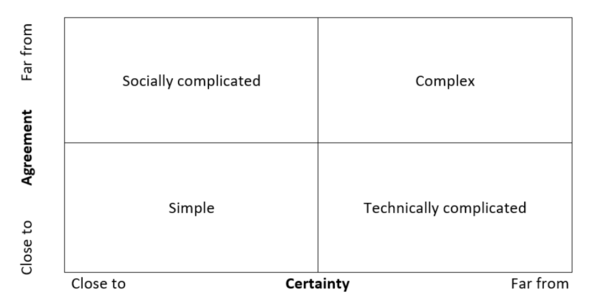Situational Complexity
The situational complexity framework was proposed by Stacey (1996) using the Agreement & Certainty Matrix shown below.
 Adapted from Zimmerman (2001); found in Patton (2011).
Adapted from Zimmerman (2001); found in Patton (2011).
The framework uses two axes:
- The level of certainty about cause and effect to solve a problem
- The level of agreement among stakeholders about the desirability of the solution
More recently, Zimmerman (2001) and Patton (2011) applied this framework to program evaluation (Chazdon & Grant, 2019). In that context, the term situational complexity refers specifically to the distinction between simple, technically complicated, socially complicated, and complex situations. This distinction is attributed to the work of organizational theorists Ralph Stacey (1996) and David Snowden (2002).
Situational Complexity in the context of Dialogic Design Science
References
- Chazdon, S., & Grant, S. (2019). Situational Complexity and the Perception of Credible Evidence. Journal of Human Sciences and Extension, 7(2), 4.
- Patton, M. Q. (2011). Developmental evaluation: Applying complexity concepts to enhance
innovation and use. New York, NY: Guilford Press.
- Snowden, D. (2002). Complex acts of knowing: Paradox and descriptive self-awareness. Journal
- Stacey, R. D. (1996). Complexity and creativity in organizations. San Francisco, CA: Berrett-
Koehler Publishers.
- Zimmerman, B.,(2001). Ralph Stacey's Agreement & Certainty Matrix, Schulich School of Business,
York University, Toronto, Canada. Online at: https://www.betterevaluation.org/en/resources/guide/ralph_staceys_agreement_and_certainty_matrix